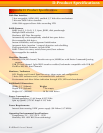
RAIDBank5 Owner’s Manual
40
DHCP (Dynamic Host Configuration Protocol) a protocol that lets network administrators
manage centrally and automate the assignment of IP (Internet Protocol) configurations on
a computer network. When using the Internet’s set of protocols (TCP/IP), in order for a
computer system to communicate to another computer system it needs a unique IP address.
Without DHCP, the IP address must be entered manually at each computer system. DHCP
lets a network administrator supervise and distribute IP addresses from a central point. The
purpose of DHCP is to provide the automatic (dynamic) allocation of IP client configurations
for a specific time period (called a lease period) and to eliminate the work necessary to
administer a large IP network.
eSATA Standardized in 2004, eSATA (e=external) provides a variant of SATA meant for
external connectivity. It has revised electrical requirements in addition to incompatible cables
and connectors to standard SATA.
Ethernet A local-area network standard that is currently the most prevalent with an estimated
80% of desktops connected using this standard. It was developed jointly by Xerox, DEC and
Intel and employs a bus or star topology.
File System A file system is a layer between applications and the disks to which their I/O
is directed. File systems serve to hide the details of the physical layout of files on the disk,
allowing applications to address files as a contiguous logical area on disk accessible by a
name regardless of their physical location on the storage device.
FireWire (IEEE 1394) is a serial bus interface standard for high-speed communications and
isochronous real-time data transfer, frequently used by personal computers, as well as in
digital audio, digital video, automotive, and aeronautics applications. FireWire can connect
up to 63 peripherals in a tree chain topology (as opposed to Parallel SCSI’s electrical bus
topology). It is designed to support Plug and play and hot swapping. The copper cable it
uses (1394’s most common implementation) can be up to 4.5 metres (15 ft) long. FireWire
400 is the most common computer application of the technology, and is capable of 400Mbit
gross bandwidth. FireWire 800 is backwards compatible with FireWire 400, but has a gross
bandwidth of 800Mbit/Sec.
Hot Spare One or more disks in a RAID array may fail at any given time. In fact, all RAID
types with the exception of RAID 0 provide methods to reconstruct the array in the event of
such an occurrence. A commonly used tactic is to earmark a hard disk that is not being used
by any RAID array as a backup. In the event a hard disk in a RAID array fails, this backup
is automatically mobilized by the RAID controller to step in place of the failed hard disk.
The data in the failed hard disk is “reconstructed” and written into the new hard disk. In the
case of a RAID 1, data is reconstructed by simply copying the contents of the surviving disk
into the spare. In the case of all other RAID types, reconstruction is performed using parity
information in the working hard disks of that RAID array. This backup hard disk is known as
a “hot” spare since the fail-over process is performed dynamically on a server within the same
session i.e., without the necessity for re-booting or powering down.
IDE (Integrated Device Electronics) A hard disk drive interface standard developed by
Western Digital. Also known as Parallel ATA.
C-Glossary


















